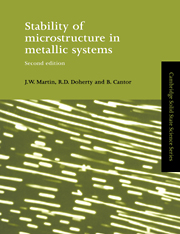Book contents
- Frontmatter
- Contents
- Preface to first edition
- Preface to second edition
- Chapter 1 The general problem of the stability of microstructure
- Chapter 2 Structural instability due to chemical free energy
- Chapter 3 Highly metastable alloys
- Chapter 4 Instability due to strain energy
- Chapter 5 Microstructural instability due to interfaces
- Chapter 6 Other causes of microstructural instability
- References
- Index
Chapter 5 - Microstructural instability due to interfaces
Published online by Cambridge University Press: 18 December 2009
- Frontmatter
- Contents
- Preface to first edition
- Preface to second edition
- Chapter 1 The general problem of the stability of microstructure
- Chapter 2 Structural instability due to chemical free energy
- Chapter 3 Highly metastable alloys
- Chapter 4 Instability due to strain energy
- Chapter 5 Microstructural instability due to interfaces
- Chapter 6 Other causes of microstructural instability
- References
- Index
Summary
Introduction
The three main interfaces which are important in metallic systems are the solid–gas interface (the external surface), the interface between two crystals of the same phase which differ only in orientation (the grain boundary) and the interface between two different phases (the interphase boundary). The interphase boundary provides an almost infinite range of possibilities since in addition to the possible difference of orientation of the two crystals, the crystals can also differ in crystal structure, lattice parameter and in composition. In this almost infinite array of possible structures and thus properties two limiting conditions can be recognised. In one case where the interface is formed, as it often is in metallic systems, by precipitation of a second phase within a primary crystal structure then a particular orientation relationship develops between the phases. This produces an interface with a close atomic fit which minimises the interfacial energy (see §2.2.2 and Doherty (1982)). This, in turn, can introduce difficulties for interfacial mobility in that growth ledges may be needed, see §1.3. The opposite extreme occurs when the two phases have no orientation relationship with each other. As a result their interface will be a high energy, incoherent one that usually provides no particular crystallographic barrier to mobility. Examples of this type of incoherent interface arise when the two phases come in contact by growth processes rather than by nucleation.
Information
- Type
- Chapter
- Information
- Stability of Microstructure in Metallic Systems , pp. 219 - 366Publisher: Cambridge University PressPrint publication year: 1997
Accessibility standard: Unknown
Why this information is here
This section outlines the accessibility features of this content - including support for screen readers, full keyboard navigation and high-contrast display options. This may not be relevant for you.Accessibility Information
- 4
- Cited by
